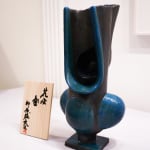Yanagihara Mutsuo 柳原睦夫 Japanese, b. 1934
H50 × W25.5 × D23 cm
Further images
-
(View a larger image of thumbnail 1
)

-
(View a larger image of thumbnail 2
)

-
(View a larger image of thumbnail 3
)

-
(View a larger image of thumbnail 4
)

-
(View a larger image of thumbnail 5
)

-
(View a larger image of thumbnail 6
)

-
(View a larger image of thumbnail 7
)

-
(View a larger image of thumbnail 8
)

-
(View a larger image of thumbnail 9
)

-
(View a larger image of thumbnail 10
)

-
(View a larger image of thumbnail 11
)

-
(View a larger image of thumbnail 12
)

-
(View a larger image of thumbnail 13
)

The Topological Vessels series reflects Yanagihara’s engagement with the mathematical field of topology—the study of spatial properties that remain constant through stretching, bending, or transformation. Fascinated by the mathematical qualities found in nature, and within this context particularly in the idea that forms can shift without breaking, he explored how vessels could appear to morph under different lighting conditions or when viewed from various angles. The result is a body of abstract works that seem to subtly transform in space, embodying his ongoing inquiry into perception, form, and material continuity.
A student of Tomimoto Kenkichi, Fujimoto Yoshimichi, and Kondo Yuzo—and a close colleague of Morino Hiroaki Taimei—Yanagihara Mutsuo is deeply rooted in Kyoto’s ceramic traditions, yet remains a radical artist who continuously redefines them through form and glaze.
In 1984, Yanagihara became a professor at Osaka University of Arts and remained there until his retirement in 2006. In his mid-60s, Yanagihara received accolade after accolade for his achievements. He was awarded the Kyoto City Art Contribution Prize in 1998, the Kyoto Prefecture Prize for Cultural Contribution in 2000, the Japan Ceramic Society Prize in 2003, and the Kyoto Art Culture Prize in 2005. After retiring from Osaka University of Arts in 2006, Yanagihara remained active and full of vigor, embarking on multiple new series, such as Counter-Vessel (han-ki 反器) in 2004, Well (ido 井戸) in 2007, Topological Standing Pots (toporo-ritsu tsubo トポロ立壷) in the latter half of the 2010s, and Exhalation and Inhalation (Koki kyūki 呼気・吸気) in the 2020s.
In his 80s, Yanagihara focused on creating single-footed, creature-like objects with round, swollen bodies and organic, uneven openings. He remained committed to his vision of forming unique shapes and achieving a symbiosis between abstract sculpture and functional vessel, challenging the dichotomy of their natures. Throughout his artistic life, Yanagihara has been devoted to playfulness and has consistently pursued a fusion of form and decoration.











